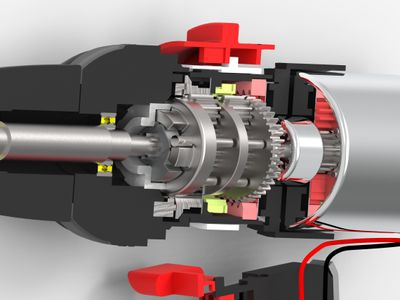The course treats mainly virtual prototype production with parameterized solid models, but the participants will also be introduced in basic surface modelling. Furthermore, the participants will obtain possibility to test, how it is to work synchronous (also called direct modelling), which possibilities and difficulties it gives.
MF2019 CAD 3D-modelling and Visualization 6.0 credits

This course supports virtual prototyping using feature-based parametric modeling. Designers and engineers need a common understanding of the performance aspects of the design before physical prototyping. In this course, students create 3D CAD-models that support efficient cooperation between individuals and groups of individuals with different types of competence. The models can be used with different downstream activities (or purposes). For example, explaining the function and manufacturability of a product, eliminating interferences between parts as the mechanism moves through the real operating range, or generating operating loads to check the design criteria using FEA.
Information per course offering
Choose semester and course offering to see current information and more about the course, such as course syllabus, study period, and application information.
Information for Autumn 2025 Start 27 Oct 2025 programme students
- Course location
KTH Campus
- Duration
- 27 Oct 2025 - 12 Jan 2026
- Periods
- P2 (6.0 hp)
- Pace of study
33%
- Application code
50535
- Form of study
Normal Daytime
- Language of instruction
English
- Course memo
- Course memo is not published
- Number of places
Min: 5
- Target group
- No information inserted
- Planned modular schedule
- [object Object]
- Schedule
Contact
Course syllabus as PDF
Please note: all information from the Course syllabus is available on this page in an accessible format.
Course syllabus MF2019 (Spring 2020–)Content and learning outcomes
Course contents
Intended learning outcomes
After passing the course, the students should be able to:
- Create a CAD model with product and manufacturing information (PMI) from a system perspective.
- Create a CAD model with mixed technical contents, e.g. mechanical and electric components.
- Be familiar with modelling modules (i.e. different applications and environments) in a CAD system for design of machine elements.
- Make force and motion analysis of a mechanism model.
- Carry out interference analyses.
- Create communicative representations of CAD models to present and describe design and behaviour of a product.
Literature and preparations
Specific prerequisites
Bachelor of Science, within Mechanical Engineering or the equivalent.
Literature
Examination and completion
If the course is discontinued, students may request to be examined during the following two academic years.
Grading scale
Examination
- ÖVN1 - Exercise, 3.0 credits, grading scale: P, F
- ÖVN2 - Project Work, 3.0 credits, grading scale: A, B, C, D, E, FX, F
Based on recommendation from KTH’s coordinator for disabilities, the examiner will decide how to adapt an examination for students with documented disability.
The examiner may apply another examination format when re-examining individual students.
To pass the course should the following be approved:
Three individual written assignments (ÖVN1; 3 credits) that should be delivered within specified time. The written assignments have grading scale P/F. If all assignments are not approved during one single course offering, all assignments must be redone in a new course offering.
The individual project part (ÖVN2; 3 credits) of the course has grading scale A-F, including the possibility to get an Fx grade. This grade reflects the course grade.
[OBSERVE: If the grade Fx is given, what is missing must be handed in and be approved before the next course offering. If not, the whole project part must be redone in a later course offering.]
If the project is not handed in during the current course offering, the project can only be handed in and be assessed twice each year (in May and in December) in connection with other course offerings. The course is developed continuously and the possibility to be assessed according to course plans of course offerings that were completed more than two years ago, may be lost, completely or partly.
Examiner
Ethical approach
- All members of a group are responsible for the group's work.
- In any assessment, every student shall honestly disclose any help received and sources used.
- In an oral assessment, every student shall be able to present and answer questions about the entire assignment and solution.